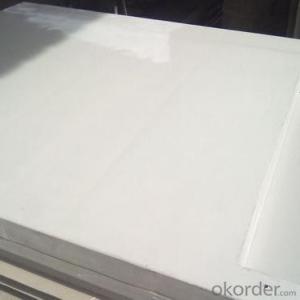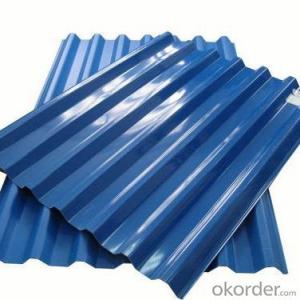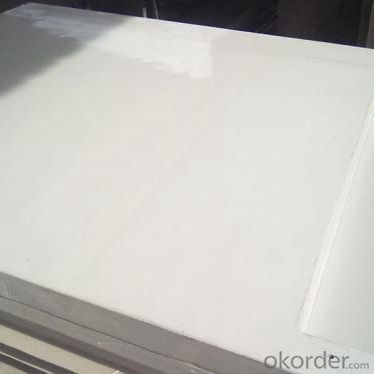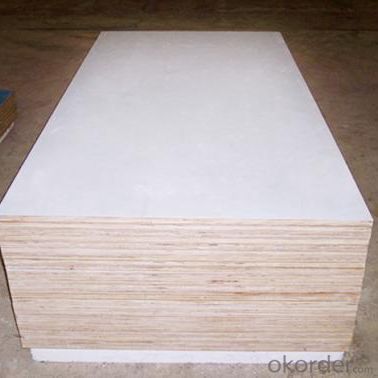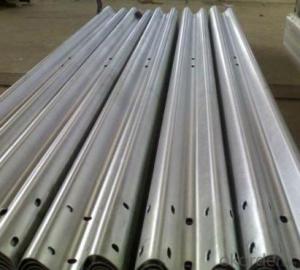FRP Roofing Panel - Up-Resin System, Glass Fiber, Gel Coat or Protective Film
- Loading Port:
- Tianjin
- Payment Terms:
- TT OR LC
- Min Order Qty:
- 300 m
- Supply Capability:
- 80000 m/month
OKorder Service Pledge
OKorder Financial Service
You Might Also Like
Specification
PRODUCT DESCRIPTION
Fiberglass roofing sheets,also named Fiberglass Reinforced Plastic(FRP),which are made of fiberglass,polyester resin and film.The film have good anti ultraviolet ,and avoid not yellow aging,premature loss of light transmission characteristics.Fiberglass roofing sheets clean surface appearance ensure the anti-static dust on the surface easily washed away by rain.
Our fiberglass roofing sheets can be widely used in industrial and residential buildings,roof and wall.Because of its stable quality and durable,we received good reputation from our customers.
FEATURES
Electrically and thermally non-conductive
Ultra-violet resistant
Provided in a number of grating thickness and panel sizes with many types of mesh size
Offers bi-directional strength characteristic
Impact resistance
Electronically transparent
SPECIFICATIONS
Product name | FRP Transparent Roofing Sheet/fiberglass skylight |
Brand | CMAX |
Material | High-performance protective film, unsaturated polyester resin, fiberglass |
Width | 900mm, 930mm, 1100mm etc. |
Thickness | 0.8mm, 1.0mm, 1.2mm, 1.5mm, 1.8mm, 2.0mm, 3.0mm etc. |
Length | 5800mm, 11800mm or customized |
Color | Clear, Blue, Green, Red and Opal etc. |
Guarantee | 10 years |
Certification | ISO9001:2015 |
Light transmittance | Base on color and thickness, will have 60%-85% |
| Delivery time | 5-7days(general) depend on the style and quantit |
| Port | Tianjin port |
| Payment terms | ALL Payment terms |
| Minimum order quantity | 500 sqm |
| Supply ability | 80000sqm per month |
PICTURES



- Q: Are FRP roofing panels compatible with solar panel installations?
- Yes, FRP (Fiberglass Reinforced Plastic) roofing panels are compatible with solar panel installations. FRP roofing panels are known for their durability, lightweight, and weather resistance, making them suitable for supporting solar panels. These panels can provide a solid and secure base for solar panels to be installed on, ensuring stability and longevity for the entire system. Additionally, FRP roofing panels have excellent thermal insulation properties, which can help regulate the temperature of the solar panels, enhancing their overall performance. Moreover, FRP panels are often translucent, allowing light to pass through and reach the solar panels, maximizing their energy generation potential. Overall, FRP roofing panels are a reliable and compatible option for solar panel installations.
- Q: Are FRP roofing panels suitable for theme parks or amusement centers?
- Yes, FRP roofing panels are suitable for theme parks and amusement centers. FRP panels are known for their durability, strength, and resistance to various environmental factors like UV rays and moisture. They are lightweight, easy to install, and require minimal maintenance, making them an ideal choice for such establishments. Additionally, FRP roofing panels come in a variety of colors and designs, allowing theme parks and amusement centers to create visually appealing structures that align with their themes.
- Q: Are FRP roofing panels suitable for extreme weather conditions?
- Yes, FRP roofing panels are suitable for extreme weather conditions. FRP stands for Fiber Reinforced Plastic, which is a durable and resilient material that can withstand various weather conditions including extreme heat, cold, wind, rain, and even hail. One of the key advantages of FRP roofing panels is their high strength-to-weight ratio, which allows them to withstand heavy wind loads and prevent damage from strong gusts. Additionally, FRP panels have excellent resistance to UV radiation, which makes them highly resistant to fading, cracking, and degradation caused by prolonged exposure to sunlight. In extreme cold conditions, FRP roofing panels have low thermal expansion and contraction rates, preventing them from cracking or warping due to temperature changes. They also have good insulating properties, which can help regulate the temperature inside the building and reduce energy consumption. Furthermore, FRP panels are highly resistant to moisture, making them ideal for areas prone to heavy rainfall or high humidity. They are non-corrosive and do not rust, ensuring long-term durability even in coastal or highly corrosive environments. Overall, FRP roofing panels are an excellent choice for extreme weather conditions due to their strength, durability, resistance to UV radiation, low thermal expansion, and resistance to moisture. They provide reliable protection for buildings and can withstand the harshest weather conditions, making them a suitable option for areas prone to extreme weather events.
- Q: Are FRP roofing panels resistant to termites or other pests?
- Termites and other pests are not typically deterred by FRP (Fiberglass Reinforced Plastic) roofing panels. Although FRP materials are recognized for their resilience and ability to withstand various elements, they remain vulnerable to termite infestation and damage caused by other pests. Termites, specifically, are known to consume and tunnel through wood and cellulose-based materials, which FRP panels lack. Nonetheless, termites can still harm the wooden structures adjacent to the FRP panels, potentially jeopardizing the roofing system's integrity. It is advisable to regularly examine and maintain the area surrounding FRP roofing panels to prevent potential pest infestations and promptly address any concerns.
- Q: Can FRP roofing panels be used for covered outdoor fitness areas or gyms?
- Yes, FRP roofing panels can be used for covered outdoor fitness areas or gyms. FRP (Fiber Reinforced Plastic) roofing panels are known for their durability, weather resistance, and ability to withstand harsh conditions. They are resistant to corrosion, UV rays, and moisture, making them suitable for outdoor applications. Additionally, FRP panels offer excellent light transmission, allowing natural light to enter the covered area, creating an inviting and well-lit space for fitness activities.
- Q: The difference between glass fiber reinforced daylight tile and PC endurance board
- The main constituents of glass are sand, quartz, and silica silicates. Many roofing materials use glass fiber to increase strength.
- Q: Are FRP roofing panels resistant to wind uplift?
- Yes, FRP roofing panels are generally resistant to wind uplift. The fiberglass-reinforced plastic material provides high strength and durability, making it capable of withstanding strong winds and reducing the risk of uplift or damage to the roofing system.
- Q: Can FRP roofing panels be used for covered parking structures or garages?
- Yes, FRP roofing panels can be used for covered parking structures or garages. FRP panels are known for their durability, resistance to weathering, and ability to withstand heavy loads. They are also lightweight, making them a suitable choice for such structures. Additionally, FRP panels can provide UV protection, which is essential for parking areas exposed to sunlight. Overall, FRP roofing panels are a reliable option for covered parking structures or garages.
- Q: Can FRP roofing panels be used for storage buildings?
- Indeed, storage buildings can utilize FRP (Fiberglass Reinforced Plastic) roofing panels. These panels possess characteristics such as being lightweight, durable, and capable of withstanding diverse weather conditions, rendering them appropriate for storage buildings. They offer exceptional defense against UV rays, corrosion, and impact, thereby guaranteeing the safety and security of the storage building's contents. Also, FRP roofing panels are renowned for their ease of installation, cost-effectiveness, and minimal upkeep requirements, all of which contribute to their widespread adoption in storage buildings.
- Q: Can FRP roofing panels be used in museums or cultural institutions?
- Museums and cultural institutions can utilize FRP (Fiberglass Reinforced Plastic) roofing panels. These panels possess durability, strength, and corrosion resistance, making them an ideal option for such environments. In order to withstand varying weather conditions like extreme temperatures, UV exposure, and moisture, museums and cultural institutions often seek roofing materials that can endure. Compared to other roofing materials, FRP roofing panels are lightweight, resulting in easier installation and handling. This advantage proves beneficial when faced with specific architectural requirements or limitations. Moreover, FRP panels can be produced in numerous colors and finishes, providing design flexibility to complement the aesthetics of the museum or cultural institution. When opting for FRP roofing panels in museums or cultural institutions, it is important to consider the potential for light transmission. Certain FRP panels are designed to allow natural light to pass through, positively impacting the display of artwork or artifacts. However, it is crucial to ensure that the light transmission properties of the panels do not have a negative impact on the conservation or preservation of delicate items. In conclusion, FRP roofing panels offer durability, corrosion resistance, and design flexibility, making them a suitable choice for museums or cultural institutions. Nonetheless, it is crucial to evaluate the specific requirements of the institution, such as light transmission, before selecting the appropriate FRP panels for the project.
Send your message to us
FRP Roofing Panel - Up-Resin System, Glass Fiber, Gel Coat or Protective Film
- Loading Port:
- Tianjin
- Payment Terms:
- TT OR LC
- Min Order Qty:
- 300 m
- Supply Capability:
- 80000 m/month
OKorder Service Pledge
OKorder Financial Service
Similar products
Hot products
Hot Searches
Related keywords
